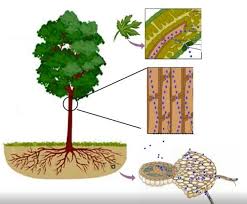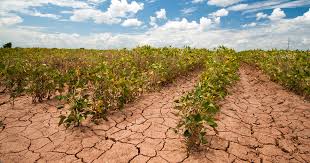The influence of global warming worldwide is creating unusual weather phenomena, often manifesting as water deficits or floods and waterlogging. Among these two, drought is considered the worst due to the prolonged exposure of plants to water-deficient conditions.
Through evolutionary mechanisms, plants have developed innate strategies to combat water stress. However, not all plants can withstand water stress, and their responses to it vary.
Even in highly tolerant plant species, tolerance is achieved through changes in molecular and physiological mechanisms that make plants morphologically adaptable to water deficits.
This adaptation comes at a cost, often resulting in reduced photosynthesis and lower biomass yields due to the conservative water management strategies adopted by plants.
These strategies help minimize water loss and maximize available water uptake while ensuring maximum utilization of physiologically available water.
Genetic mechanisms enable plants to produce enzymes, proteins, and molecules that combat water shortages. This article will explore the importance of water to crops, the causes and effects of water stress, and plant responses to water stress.
Read Also: Introduction to Rabbit Rearing
Importance of Water to Plants

Water is a vital element for plant growth. At their vegetative growth stages, plants contain 80-90 percent water, which keeps them turgid and erect. Under normal atmospheric conditions, moisture is continually evaporated or transpired from the leaves and tender portions of plants.
To replace the lost water, plants absorb it from the soil. The presence of water in plants helps regulate their temperature, particularly under intense sunlight, where increased transpiration prevents the rise of internal temperature.
Soil moisture also contains essential nutrients necessary for plant growth and development. Water is crucial for the following functions in plants:
1. Providing moisture that constitutes plant materials.
2. Meeting transpiration, respiration, and photosynthetic requirements.
3. Regulating the temperature of the plant system.
4. Serving as a medium for dissolving nutrients from the soil, fulfilling the physiological needs of growing plants.
When plants receive sufficient water, improvements in growth and final yields are observed.
Causes of Water Stress in Plants
Water stress occurs when the water supply to plant roots becomes limiting or when transpiration rates become excessive. The primary causes of water stress are water deficits, such as drought or high soil salinity.
In cases of high soil salinity and other conditions like flooding and low soil temperature, water exists in the soil solution, but plants cannot absorb it—this is known as ‘physiological drought.’
Drought occurs annually in many parts of the world, with higher frequency in arid and semi-arid climates. Regions with adequate but non-uniform precipitation also experience water-limiting environments.
Since the inception of agriculture, drought, ranging from mild to severe, has been one of the major factors limiting field crop production.
Consequently, the ability of plants to withstand such stress is of significant economic importance. While all plants exhibit some level of tolerance to water stress, the extent of tolerance varies between species.
Effects of Water Stress on Plants

Drought is an abiotic stress with multifaceted effects on plants, affecting them at various organizational levels. Under prolonged drought conditions, many plants dehydrate and die. Water stress reduces the plant-cell’s water potential and turgor.
The impacts of drought are not only seen in plant-water relations—through reductions in water content, turgor, and total water but also in stomatal closure, limited gaseous exchange, reduced transpiration, and arrested carbon assimilation (photosynthesis).
Additionally, water stress negatively affects mineral nutrition (nutrient uptake and transport), leading to a decrease in leaf area and altering the distribution of assimilates among plant organs. Changes in plant cell wall elasticity and disruption of ion distribution within cells have been reported.
The synthesis of proteins associated with the drought response is another outcome of water stress. During water stress, cell expansion slows or ceases, and plant growth is significantly retarded.
Water stress impacts plant growth more through altered photosynthesis, respiration, translocation, ion uptake, carbohydrate and nutrient metabolism, and hormones. Drought creates an imbalance between light capture and its utilization, inhibiting photosynthesis in leaves.
Plant Responses to Water Stress
Plants respond to drought conditions through a variety of physiological, biochemical, anatomical, and morphological changes, including shifts in gene expression. The overall response of plants to drought stress is complex and involves both harmful and adaptive changes.
Factors such as plant species and variety, the dynamics, duration, and intensity of soil water depletion, changes in atmospheric water demand, environmental conditions, and the plant’s growth and phenological state all influence this response.
To cope with drought, plants employ a combination of stress avoidance and tolerance strategies. Early responses to drought stress enable plants to survive for some time.
Acclimation to drought is indicated by the accumulation of specific metabolites and structural changes that improve plant functioning under stress. The main aspects of plant responses to water stress involve the maintenance of homeostasis, including ionic balance and osmotic adjustment.
Read Also: 10 Health Benefits of Rabbit Meat
Resistance to Water Stress in Plants

Plants optimize the morphology, physiology, and metabolism of their organs and cells to maximize productivity under drought conditions. The plant’s response to water stress differs significantly across various organizational levels, depending on the intensity and duration of stress, as well as plant species and developmental stage.
Stress resistance in plants can be categorized into two main types: stress tolerance and stress avoidance.
Drought avoidance refers to the ability of plants to maintain high tissue water potential during drought conditions, while drought tolerance enables plants to maintain normal functions despite low tissue water potentials.
Drought avoidance is often achieved through morphological changes, such as reduced stomatal conductance, decreased leaf area, the development of extensive root systems, and increased root-to-shoot ratios.
In contrast, drought tolerance involves cell and tissue-specific physiological, biochemical, and molecular mechanisms, including specific gene expression and the accumulation of proteins that aid in stress management.
In drought-tolerant plants, dehydration is associated with significant changes in water relations, biochemical processes, membrane structure, and the ultrastructure of sub-cellular organelles.
Some plants cope with arid environments by employing mechanisms that mitigate drought stress, such as stomatal closure, partial senescence of tissues, reduction in leaf growth, development of water storage organs, and increased root length and density to use water more efficiently.
Do you have any questions, suggestions, or contributions? If so, please feel free to use the comment box below to share your thoughts. We also encourage you to kindly share this information with others who might benefit from it. Since we can’t reach everyone at once, we truly appreciate your help in spreading the word. Thank you so much for your support and for sharing!
Frequently Asked Questions
We will update this section soon.

